A Report on Health Promotion and Cardiovascular Illness in the UK
VerifiedAdded on 2023/06/14
|7
|2144
|267
Report
AI Summary
This report examines the risk factors associated with cardiovascular illness in the UK, including lifestyle choices, genetics, and biological factors. It explores various health promotion models, such as behavioral change, self-empowerment, and collective action theory, to mitigate these risks. The report highlights the importance of physical activity, healthy diets, and public policies in reducing the prevalence of cardiovascular illness among both young and older adults. It concludes that adopting healthy lifestyles and implementing effective health promotion strategies are crucial for improving well-being and decreasing the incidence of cardiovascular illness in the UK population. Desklib provides access to similar reports and solved assignments for students.

Health report.
Paraphrase This Document
Need a fresh take? Get an instant paraphrase of this document with our AI Paraphraser
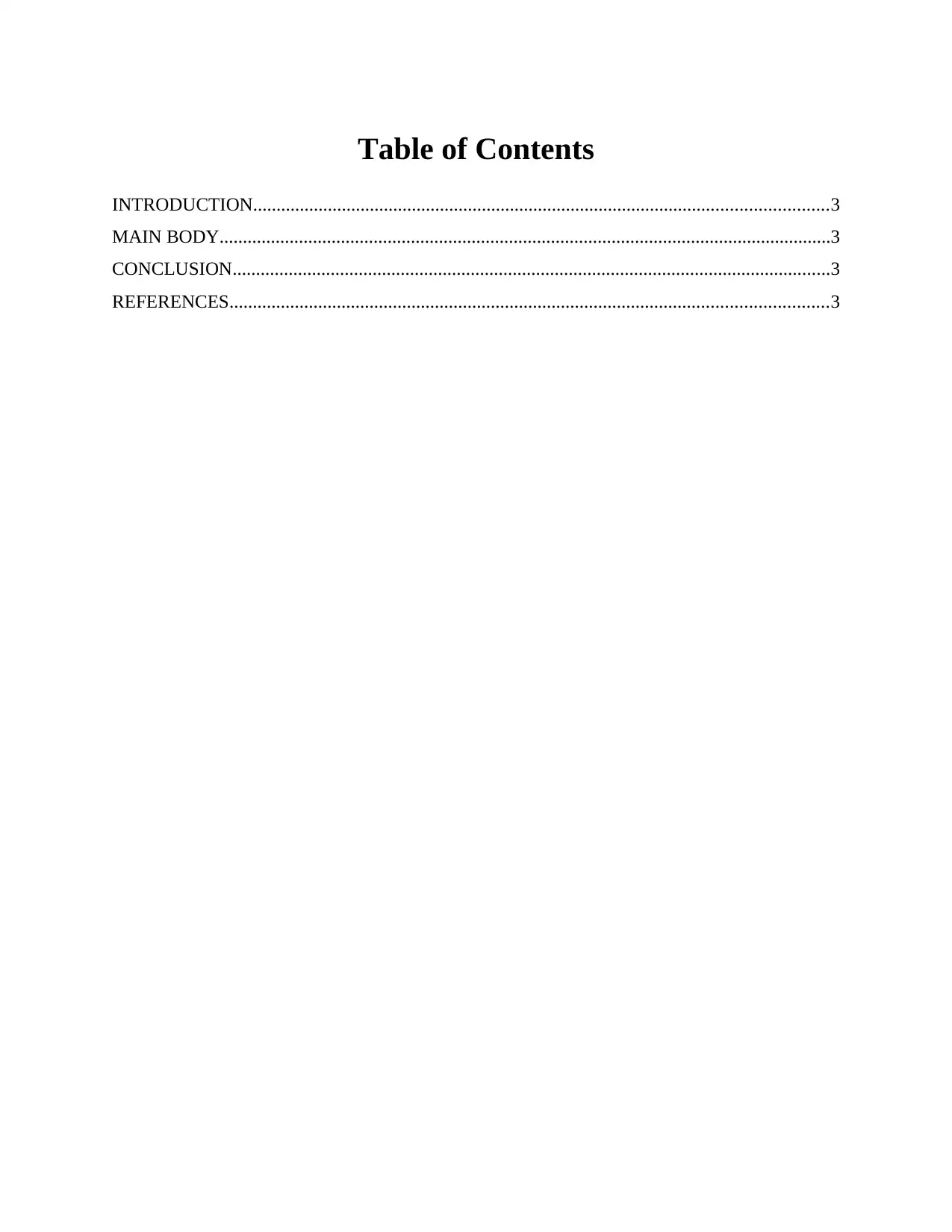
Table of Contents
INTRODUCTION...........................................................................................................................3
MAIN BODY...................................................................................................................................3
CONCLUSION................................................................................................................................3
REFERENCES................................................................................................................................3
INTRODUCTION...........................................................................................................................3
MAIN BODY...................................................................................................................................3
CONCLUSION................................................................................................................................3
REFERENCES................................................................................................................................3
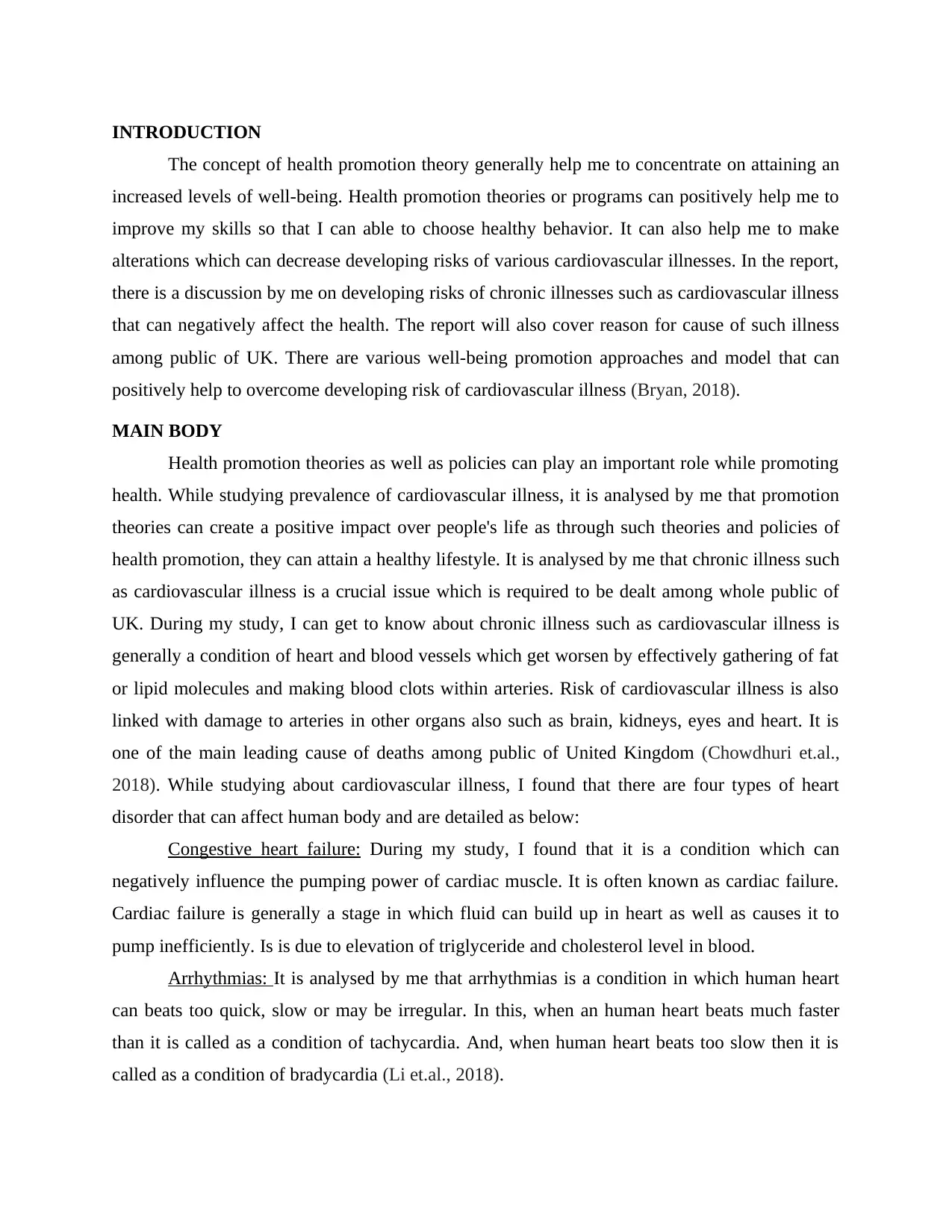
INTRODUCTION
The concept of health promotion theory generally help me to concentrate on attaining an
increased levels of well-being. Health promotion theories or programs can positively help me to
improve my skills so that I can able to choose healthy behavior. It can also help me to make
alterations which can decrease developing risks of various cardiovascular illnesses. In the report,
there is a discussion by me on developing risks of chronic illnesses such as cardiovascular illness
that can negatively affect the health. The report will also cover reason for cause of such illness
among public of UK. There are various well-being promotion approaches and model that can
positively help to overcome developing risk of cardiovascular illness (Bryan, 2018).
MAIN BODY
Health promotion theories as well as policies can play an important role while promoting
health. While studying prevalence of cardiovascular illness, it is analysed by me that promotion
theories can create a positive impact over people's life as through such theories and policies of
health promotion, they can attain a healthy lifestyle. It is analysed by me that chronic illness such
as cardiovascular illness is a crucial issue which is required to be dealt among whole public of
UK. During my study, I can get to know about chronic illness such as cardiovascular illness is
generally a condition of heart and blood vessels which get worsen by effectively gathering of fat
or lipid molecules and making blood clots within arteries. Risk of cardiovascular illness is also
linked with damage to arteries in other organs also such as brain, kidneys, eyes and heart. It is
one of the main leading cause of deaths among public of United Kingdom (Chowdhuri et.al.,
2018). While studying about cardiovascular illness, I found that there are four types of heart
disorder that can affect human body and are detailed as below:
Congestive heart failure: During my study, I found that it is a condition which can
negatively influence the pumping power of cardiac muscle. It is often known as cardiac failure.
Cardiac failure is generally a stage in which fluid can build up in heart as well as causes it to
pump inefficiently. Is is due to elevation of triglyceride and cholesterol level in blood.
Arrhythmias: It is analysed by me that arrhythmias is a condition in which human heart
can beats too quick, slow or may be irregular. In this, when an human heart beats much faster
than it is called as a condition of tachycardia. And, when human heart beats too slow then it is
called as a condition of bradycardia (Li et.al., 2018).
The concept of health promotion theory generally help me to concentrate on attaining an
increased levels of well-being. Health promotion theories or programs can positively help me to
improve my skills so that I can able to choose healthy behavior. It can also help me to make
alterations which can decrease developing risks of various cardiovascular illnesses. In the report,
there is a discussion by me on developing risks of chronic illnesses such as cardiovascular illness
that can negatively affect the health. The report will also cover reason for cause of such illness
among public of UK. There are various well-being promotion approaches and model that can
positively help to overcome developing risk of cardiovascular illness (Bryan, 2018).
MAIN BODY
Health promotion theories as well as policies can play an important role while promoting
health. While studying prevalence of cardiovascular illness, it is analysed by me that promotion
theories can create a positive impact over people's life as through such theories and policies of
health promotion, they can attain a healthy lifestyle. It is analysed by me that chronic illness such
as cardiovascular illness is a crucial issue which is required to be dealt among whole public of
UK. During my study, I can get to know about chronic illness such as cardiovascular illness is
generally a condition of heart and blood vessels which get worsen by effectively gathering of fat
or lipid molecules and making blood clots within arteries. Risk of cardiovascular illness is also
linked with damage to arteries in other organs also such as brain, kidneys, eyes and heart. It is
one of the main leading cause of deaths among public of United Kingdom (Chowdhuri et.al.,
2018). While studying about cardiovascular illness, I found that there are four types of heart
disorder that can affect human body and are detailed as below:
Congestive heart failure: During my study, I found that it is a condition which can
negatively influence the pumping power of cardiac muscle. It is often known as cardiac failure.
Cardiac failure is generally a stage in which fluid can build up in heart as well as causes it to
pump inefficiently. Is is due to elevation of triglyceride and cholesterol level in blood.
Arrhythmias: It is analysed by me that arrhythmias is a condition in which human heart
can beats too quick, slow or may be irregular. In this, when an human heart beats much faster
than it is called as a condition of tachycardia. And, when human heart beats too slow then it is
called as a condition of bradycardia (Li et.al., 2018).
⊘ This is a preview!⊘
Do you want full access?
Subscribe today to unlock all pages.

Trusted by 1+ million students worldwide
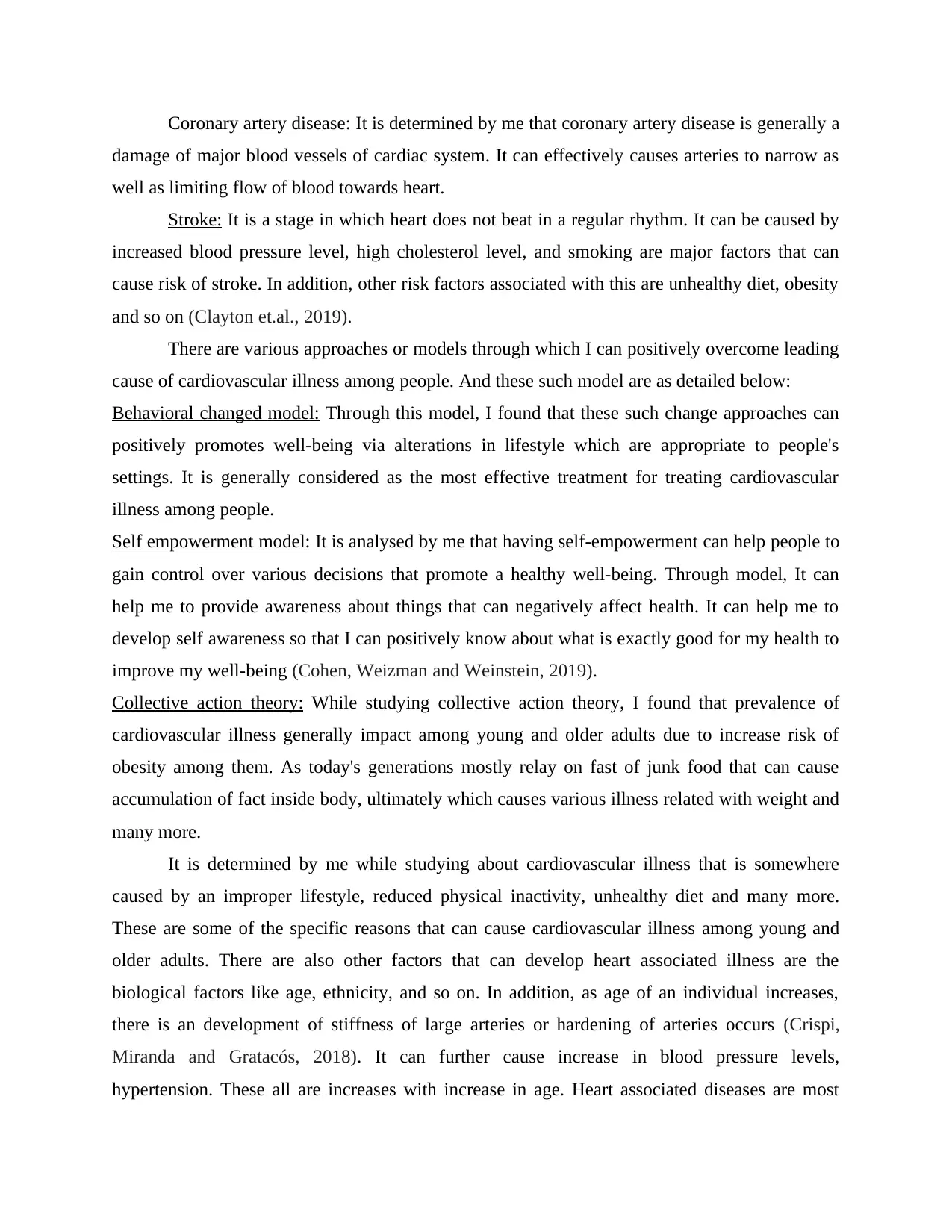
Coronary artery disease: It is determined by me that coronary artery disease is generally a
damage of major blood vessels of cardiac system. It can effectively causes arteries to narrow as
well as limiting flow of blood towards heart.
Stroke: It is a stage in which heart does not beat in a regular rhythm. It can be caused by
increased blood pressure level, high cholesterol level, and smoking are major factors that can
cause risk of stroke. In addition, other risk factors associated with this are unhealthy diet, obesity
and so on (Clayton et.al., 2019).
There are various approaches or models through which I can positively overcome leading
cause of cardiovascular illness among people. And these such model are as detailed below:
Behavioral changed model: Through this model, I found that these such change approaches can
positively promotes well-being via alterations in lifestyle which are appropriate to people's
settings. It is generally considered as the most effective treatment for treating cardiovascular
illness among people.
Self empowerment model: It is analysed by me that having self-empowerment can help people to
gain control over various decisions that promote a healthy well-being. Through model, It can
help me to provide awareness about things that can negatively affect health. It can help me to
develop self awareness so that I can positively know about what is exactly good for my health to
improve my well-being (Cohen, Weizman and Weinstein, 2019).
Collective action theory: While studying collective action theory, I found that prevalence of
cardiovascular illness generally impact among young and older adults due to increase risk of
obesity among them. As today's generations mostly relay on fast of junk food that can cause
accumulation of fact inside body, ultimately which causes various illness related with weight and
many more.
It is determined by me while studying about cardiovascular illness that is somewhere
caused by an improper lifestyle, reduced physical inactivity, unhealthy diet and many more.
These are some of the specific reasons that can cause cardiovascular illness among young and
older adults. There are also other factors that can develop heart associated illness are the
biological factors like age, ethnicity, and so on. In addition, as age of an individual increases,
there is an development of stiffness of large arteries or hardening of arteries occurs (Crispi,
Miranda and Gratacós, 2018). It can further cause increase in blood pressure levels,
hypertension. These all are increases with increase in age. Heart associated diseases are most
damage of major blood vessels of cardiac system. It can effectively causes arteries to narrow as
well as limiting flow of blood towards heart.
Stroke: It is a stage in which heart does not beat in a regular rhythm. It can be caused by
increased blood pressure level, high cholesterol level, and smoking are major factors that can
cause risk of stroke. In addition, other risk factors associated with this are unhealthy diet, obesity
and so on (Clayton et.al., 2019).
There are various approaches or models through which I can positively overcome leading
cause of cardiovascular illness among people. And these such model are as detailed below:
Behavioral changed model: Through this model, I found that these such change approaches can
positively promotes well-being via alterations in lifestyle which are appropriate to people's
settings. It is generally considered as the most effective treatment for treating cardiovascular
illness among people.
Self empowerment model: It is analysed by me that having self-empowerment can help people to
gain control over various decisions that promote a healthy well-being. Through model, It can
help me to provide awareness about things that can negatively affect health. It can help me to
develop self awareness so that I can positively know about what is exactly good for my health to
improve my well-being (Cohen, Weizman and Weinstein, 2019).
Collective action theory: While studying collective action theory, I found that prevalence of
cardiovascular illness generally impact among young and older adults due to increase risk of
obesity among them. As today's generations mostly relay on fast of junk food that can cause
accumulation of fact inside body, ultimately which causes various illness related with weight and
many more.
It is determined by me while studying about cardiovascular illness that is somewhere
caused by an improper lifestyle, reduced physical inactivity, unhealthy diet and many more.
These are some of the specific reasons that can cause cardiovascular illness among young and
older adults. There are also other factors that can develop heart associated illness are the
biological factors like age, ethnicity, and so on. In addition, as age of an individual increases,
there is an development of stiffness of large arteries or hardening of arteries occurs (Crispi,
Miranda and Gratacós, 2018). It can further cause increase in blood pressure levels,
hypertension. These all are increases with increase in age. Heart associated diseases are most
Paraphrase This Document
Need a fresh take? Get an instant paraphrase of this document with our AI Paraphraser
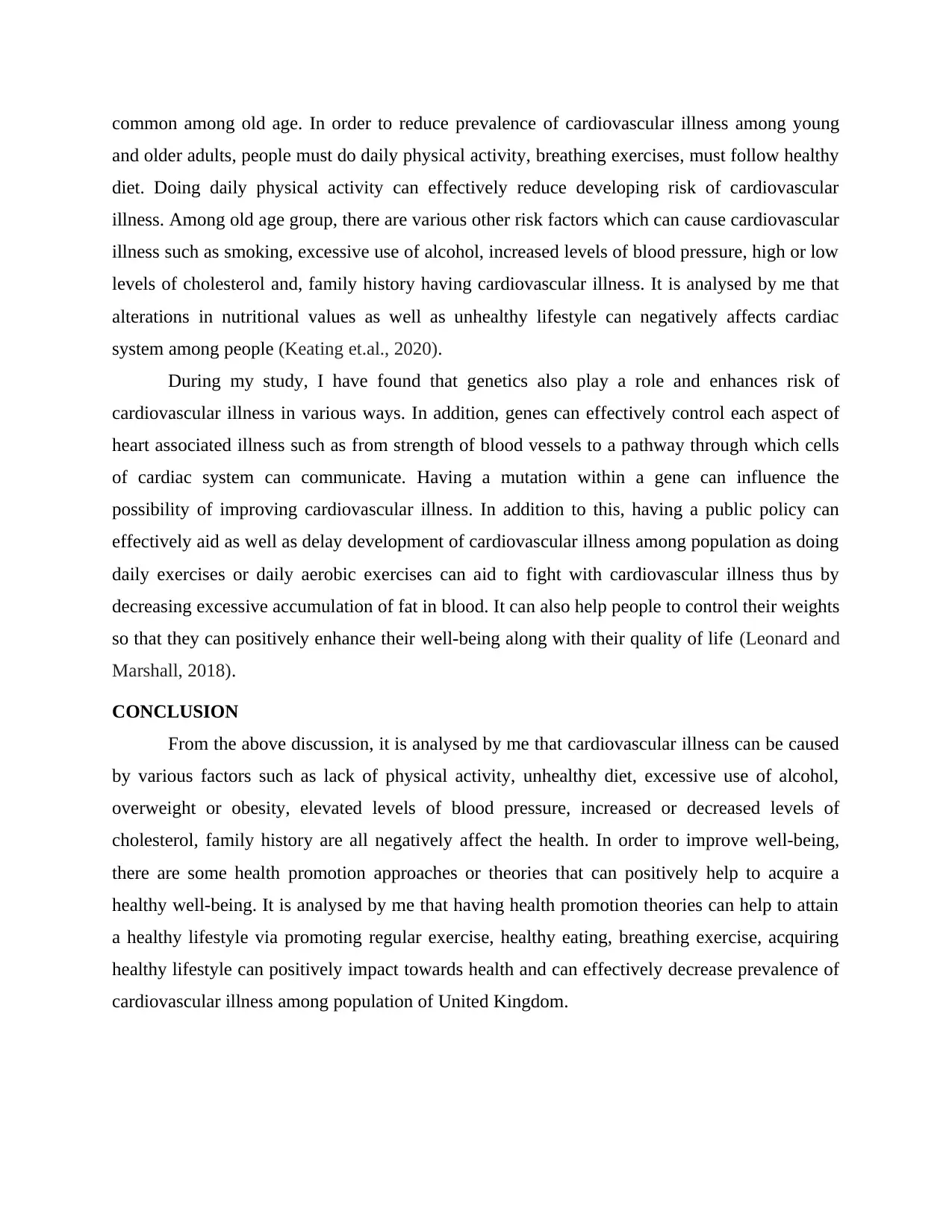
common among old age. In order to reduce prevalence of cardiovascular illness among young
and older adults, people must do daily physical activity, breathing exercises, must follow healthy
diet. Doing daily physical activity can effectively reduce developing risk of cardiovascular
illness. Among old age group, there are various other risk factors which can cause cardiovascular
illness such as smoking, excessive use of alcohol, increased levels of blood pressure, high or low
levels of cholesterol and, family history having cardiovascular illness. It is analysed by me that
alterations in nutritional values as well as unhealthy lifestyle can negatively affects cardiac
system among people (Keating et.al., 2020).
During my study, I have found that genetics also play a role and enhances risk of
cardiovascular illness in various ways. In addition, genes can effectively control each aspect of
heart associated illness such as from strength of blood vessels to a pathway through which cells
of cardiac system can communicate. Having a mutation within a gene can influence the
possibility of improving cardiovascular illness. In addition to this, having a public policy can
effectively aid as well as delay development of cardiovascular illness among population as doing
daily exercises or daily aerobic exercises can aid to fight with cardiovascular illness thus by
decreasing excessive accumulation of fat in blood. It can also help people to control their weights
so that they can positively enhance their well-being along with their quality of life (Leonard and
Marshall, 2018).
CONCLUSION
From the above discussion, it is analysed by me that cardiovascular illness can be caused
by various factors such as lack of physical activity, unhealthy diet, excessive use of alcohol,
overweight or obesity, elevated levels of blood pressure, increased or decreased levels of
cholesterol, family history are all negatively affect the health. In order to improve well-being,
there are some health promotion approaches or theories that can positively help to acquire a
healthy well-being. It is analysed by me that having health promotion theories can help to attain
a healthy lifestyle via promoting regular exercise, healthy eating, breathing exercise, acquiring
healthy lifestyle can positively impact towards health and can effectively decrease prevalence of
cardiovascular illness among population of United Kingdom.
and older adults, people must do daily physical activity, breathing exercises, must follow healthy
diet. Doing daily physical activity can effectively reduce developing risk of cardiovascular
illness. Among old age group, there are various other risk factors which can cause cardiovascular
illness such as smoking, excessive use of alcohol, increased levels of blood pressure, high or low
levels of cholesterol and, family history having cardiovascular illness. It is analysed by me that
alterations in nutritional values as well as unhealthy lifestyle can negatively affects cardiac
system among people (Keating et.al., 2020).
During my study, I have found that genetics also play a role and enhances risk of
cardiovascular illness in various ways. In addition, genes can effectively control each aspect of
heart associated illness such as from strength of blood vessels to a pathway through which cells
of cardiac system can communicate. Having a mutation within a gene can influence the
possibility of improving cardiovascular illness. In addition to this, having a public policy can
effectively aid as well as delay development of cardiovascular illness among population as doing
daily exercises or daily aerobic exercises can aid to fight with cardiovascular illness thus by
decreasing excessive accumulation of fat in blood. It can also help people to control their weights
so that they can positively enhance their well-being along with their quality of life (Leonard and
Marshall, 2018).
CONCLUSION
From the above discussion, it is analysed by me that cardiovascular illness can be caused
by various factors such as lack of physical activity, unhealthy diet, excessive use of alcohol,
overweight or obesity, elevated levels of blood pressure, increased or decreased levels of
cholesterol, family history are all negatively affect the health. In order to improve well-being,
there are some health promotion approaches or theories that can positively help to acquire a
healthy well-being. It is analysed by me that having health promotion theories can help to attain
a healthy lifestyle via promoting regular exercise, healthy eating, breathing exercise, acquiring
healthy lifestyle can positively impact towards health and can effectively decrease prevalence of
cardiovascular illness among population of United Kingdom.
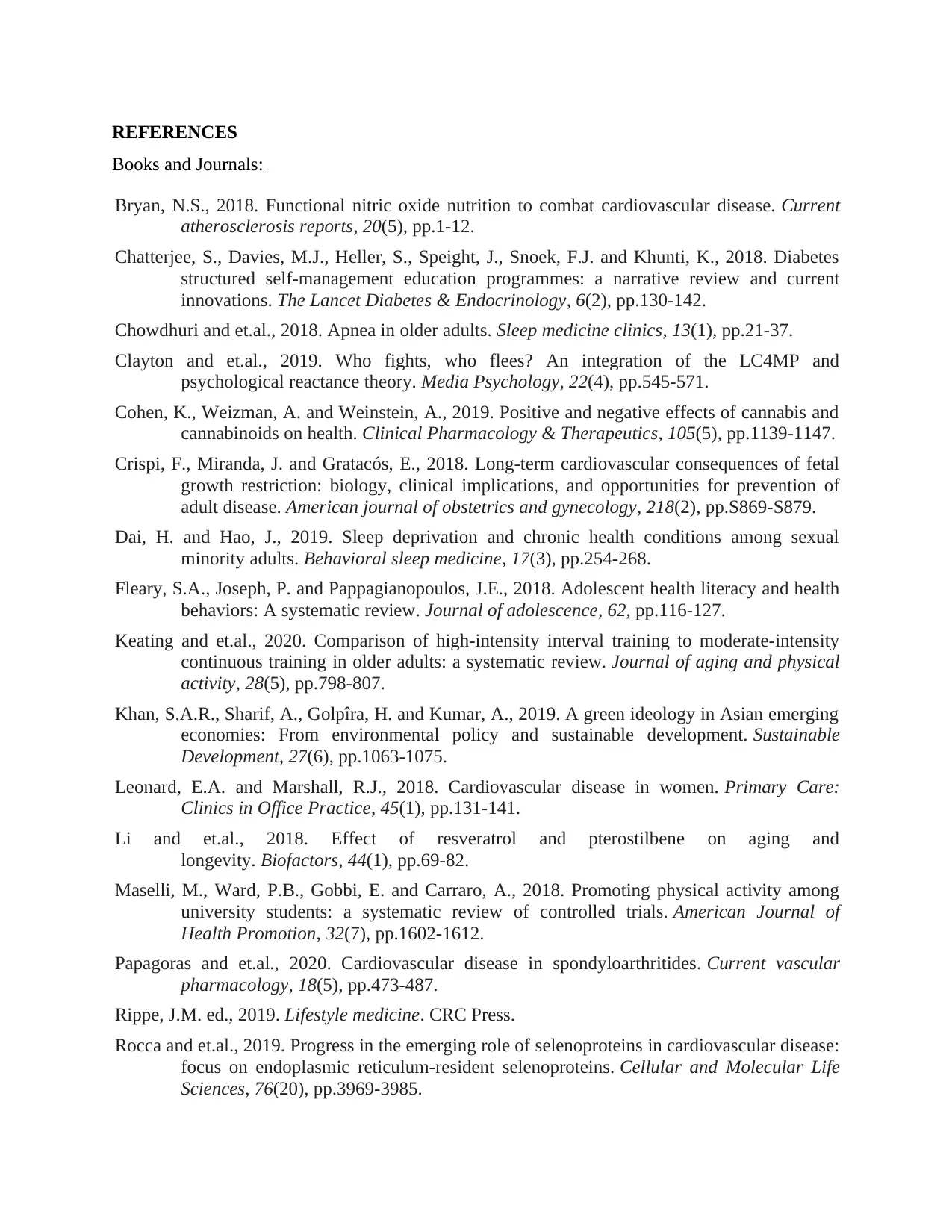
REFERENCES
Books and Journals:
Bryan, N.S., 2018. Functional nitric oxide nutrition to combat cardiovascular disease. Current
atherosclerosis reports, 20(5), pp.1-12.
Chatterjee, S., Davies, M.J., Heller, S., Speight, J., Snoek, F.J. and Khunti, K., 2018. Diabetes
structured self-management education programmes: a narrative review and current
innovations. The Lancet Diabetes & Endocrinology, 6(2), pp.130-142.
Chowdhuri and et.al., 2018. Apnea in older adults. Sleep medicine clinics, 13(1), pp.21-37.
Clayton and et.al., 2019. Who fights, who flees? An integration of the LC4MP and
psychological reactance theory. Media Psychology, 22(4), pp.545-571.
Cohen, K., Weizman, A. and Weinstein, A., 2019. Positive and negative effects of cannabis and
cannabinoids on health. Clinical Pharmacology & Therapeutics, 105(5), pp.1139-1147.
Crispi, F., Miranda, J. and Gratacós, E., 2018. Long-term cardiovascular consequences of fetal
growth restriction: biology, clinical implications, and opportunities for prevention of
adult disease. American journal of obstetrics and gynecology, 218(2), pp.S869-S879.
Dai, H. and Hao, J., 2019. Sleep deprivation and chronic health conditions among sexual
minority adults. Behavioral sleep medicine, 17(3), pp.254-268.
Fleary, S.A., Joseph, P. and Pappagianopoulos, J.E., 2018. Adolescent health literacy and health
behaviors: A systematic review. Journal of adolescence, 62, pp.116-127.
Keating and et.al., 2020. Comparison of high-intensity interval training to moderate-intensity
continuous training in older adults: a systematic review. Journal of aging and physical
activity, 28(5), pp.798-807.
Khan, S.A.R., Sharif, A., Golpîra, H. and Kumar, A., 2019. A green ideology in Asian emerging
economies: From environmental policy and sustainable development. Sustainable
Development, 27(6), pp.1063-1075.
Leonard, E.A. and Marshall, R.J., 2018. Cardiovascular disease in women. Primary Care:
Clinics in Office Practice, 45(1), pp.131-141.
Li and et.al., 2018. Effect of resveratrol and pterostilbene on aging and
longevity. Biofactors, 44(1), pp.69-82.
Maselli, M., Ward, P.B., Gobbi, E. and Carraro, A., 2018. Promoting physical activity among
university students: a systematic review of controlled trials. American Journal of
Health Promotion, 32(7), pp.1602-1612.
Papagoras and et.al., 2020. Cardiovascular disease in spondyloarthritides. Current vascular
pharmacology, 18(5), pp.473-487.
Rippe, J.M. ed., 2019. Lifestyle medicine. CRC Press.
Rocca and et.al., 2019. Progress in the emerging role of selenoproteins in cardiovascular disease:
focus on endoplasmic reticulum-resident selenoproteins. Cellular and Molecular Life
Sciences, 76(20), pp.3969-3985.
Books and Journals:
Bryan, N.S., 2018. Functional nitric oxide nutrition to combat cardiovascular disease. Current
atherosclerosis reports, 20(5), pp.1-12.
Chatterjee, S., Davies, M.J., Heller, S., Speight, J., Snoek, F.J. and Khunti, K., 2018. Diabetes
structured self-management education programmes: a narrative review and current
innovations. The Lancet Diabetes & Endocrinology, 6(2), pp.130-142.
Chowdhuri and et.al., 2018. Apnea in older adults. Sleep medicine clinics, 13(1), pp.21-37.
Clayton and et.al., 2019. Who fights, who flees? An integration of the LC4MP and
psychological reactance theory. Media Psychology, 22(4), pp.545-571.
Cohen, K., Weizman, A. and Weinstein, A., 2019. Positive and negative effects of cannabis and
cannabinoids on health. Clinical Pharmacology & Therapeutics, 105(5), pp.1139-1147.
Crispi, F., Miranda, J. and Gratacós, E., 2018. Long-term cardiovascular consequences of fetal
growth restriction: biology, clinical implications, and opportunities for prevention of
adult disease. American journal of obstetrics and gynecology, 218(2), pp.S869-S879.
Dai, H. and Hao, J., 2019. Sleep deprivation and chronic health conditions among sexual
minority adults. Behavioral sleep medicine, 17(3), pp.254-268.
Fleary, S.A., Joseph, P. and Pappagianopoulos, J.E., 2018. Adolescent health literacy and health
behaviors: A systematic review. Journal of adolescence, 62, pp.116-127.
Keating and et.al., 2020. Comparison of high-intensity interval training to moderate-intensity
continuous training in older adults: a systematic review. Journal of aging and physical
activity, 28(5), pp.798-807.
Khan, S.A.R., Sharif, A., Golpîra, H. and Kumar, A., 2019. A green ideology in Asian emerging
economies: From environmental policy and sustainable development. Sustainable
Development, 27(6), pp.1063-1075.
Leonard, E.A. and Marshall, R.J., 2018. Cardiovascular disease in women. Primary Care:
Clinics in Office Practice, 45(1), pp.131-141.
Li and et.al., 2018. Effect of resveratrol and pterostilbene on aging and
longevity. Biofactors, 44(1), pp.69-82.
Maselli, M., Ward, P.B., Gobbi, E. and Carraro, A., 2018. Promoting physical activity among
university students: a systematic review of controlled trials. American Journal of
Health Promotion, 32(7), pp.1602-1612.
Papagoras and et.al., 2020. Cardiovascular disease in spondyloarthritides. Current vascular
pharmacology, 18(5), pp.473-487.
Rippe, J.M. ed., 2019. Lifestyle medicine. CRC Press.
Rocca and et.al., 2019. Progress in the emerging role of selenoproteins in cardiovascular disease:
focus on endoplasmic reticulum-resident selenoproteins. Cellular and Molecular Life
Sciences, 76(20), pp.3969-3985.
⊘ This is a preview!⊘
Do you want full access?
Subscribe today to unlock all pages.

Trusted by 1+ million students worldwide
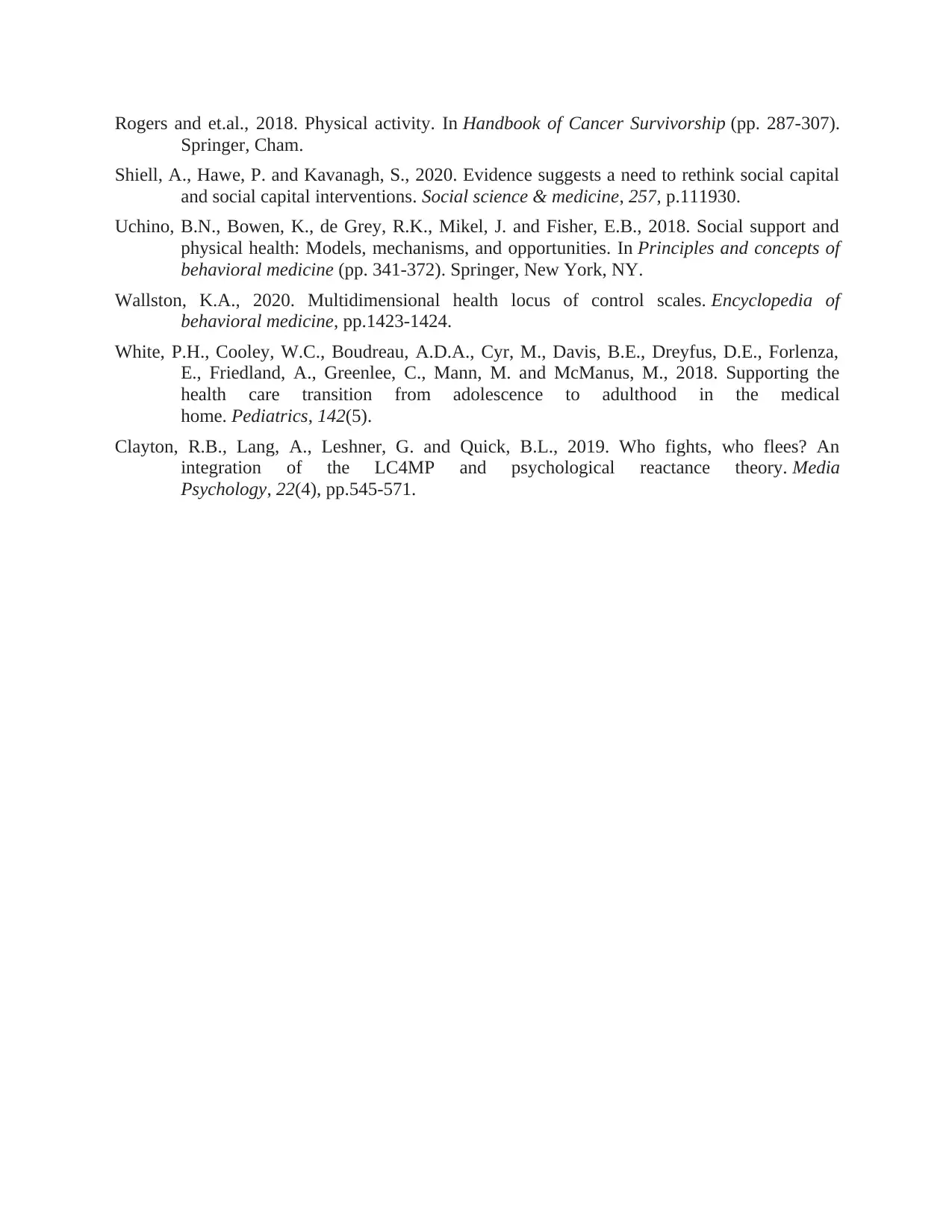
Rogers and et.al., 2018. Physical activity. In Handbook of Cancer Survivorship (pp. 287-307).
Springer, Cham.
Shiell, A., Hawe, P. and Kavanagh, S., 2020. Evidence suggests a need to rethink social capital
and social capital interventions. Social science & medicine, 257, p.111930.
Uchino, B.N., Bowen, K., de Grey, R.K., Mikel, J. and Fisher, E.B., 2018. Social support and
physical health: Models, mechanisms, and opportunities. In Principles and concepts of
behavioral medicine (pp. 341-372). Springer, New York, NY.
Wallston, K.A., 2020. Multidimensional health locus of control scales. Encyclopedia of
behavioral medicine, pp.1423-1424.
White, P.H., Cooley, W.C., Boudreau, A.D.A., Cyr, M., Davis, B.E., Dreyfus, D.E., Forlenza,
E., Friedland, A., Greenlee, C., Mann, M. and McManus, M., 2018. Supporting the
health care transition from adolescence to adulthood in the medical
home. Pediatrics, 142(5).
Clayton, R.B., Lang, A., Leshner, G. and Quick, B.L., 2019. Who fights, who flees? An
integration of the LC4MP and psychological reactance theory. Media
Psychology, 22(4), pp.545-571.
Springer, Cham.
Shiell, A., Hawe, P. and Kavanagh, S., 2020. Evidence suggests a need to rethink social capital
and social capital interventions. Social science & medicine, 257, p.111930.
Uchino, B.N., Bowen, K., de Grey, R.K., Mikel, J. and Fisher, E.B., 2018. Social support and
physical health: Models, mechanisms, and opportunities. In Principles and concepts of
behavioral medicine (pp. 341-372). Springer, New York, NY.
Wallston, K.A., 2020. Multidimensional health locus of control scales. Encyclopedia of
behavioral medicine, pp.1423-1424.
White, P.H., Cooley, W.C., Boudreau, A.D.A., Cyr, M., Davis, B.E., Dreyfus, D.E., Forlenza,
E., Friedland, A., Greenlee, C., Mann, M. and McManus, M., 2018. Supporting the
health care transition from adolescence to adulthood in the medical
home. Pediatrics, 142(5).
Clayton, R.B., Lang, A., Leshner, G. and Quick, B.L., 2019. Who fights, who flees? An
integration of the LC4MP and psychological reactance theory. Media
Psychology, 22(4), pp.545-571.
1 out of 7
Related Documents
Your All-in-One AI-Powered Toolkit for Academic Success.
+13062052269
info@desklib.com
Available 24*7 on WhatsApp / Email
![[object Object]](/_next/static/media/star-bottom.7253800d.svg)
Unlock your academic potential
Copyright © 2020–2025 A2Z Services. All Rights Reserved. Developed and managed by ZUCOL.



